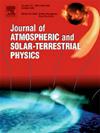Observed thermodynamical-cloud-rain characteristics during pre-monsoon precipitating events over a high-altitude site in Western Ghats, India
IF 1.9
4区 地球科学
Q3 GEOCHEMISTRY & GEOPHYSICS
Journal of Atmospheric and Solar-Terrestrial Physics
Pub Date : 2025-02-13
DOI:10.1016/j.jastp.2025.106459
引用次数: 0
Abstract
The present study detailed the atmospheric stability and cloud-rain properties during pre-monsoon precipitating events using co-located ground-based observation of a high-altitude site, in Western Ghats, India. The meteorological - moisture parameters and stability indices showed strong diurnal and seasonal variation over the study region. Higher values in the stability indices and moisture parameters were noted throughout the day (during afternoon hours) of monsoon (pre- and post-monsoon) suggesting the possibility of convective activity over the study region. Features of layered clouds mostly, with low bases were noticed during monsoon, followed by pre- and post-monsoon.
A detailed analysis of meteorological-moisture parameters, stability indices, and cloud properties during pre-monsoon, highlighted an apparent change in these parameters from non-precipitating to precipitating events. Strong precipitating event were characterized by higher low-level moisture,sharp changes in the meteorological parameters and few stability indices. Higher values of radar reflectivity (>40 dBz) indicated strong precipitating event as a convective storm. Higher liquid and lower values of brightness temperature confirmed the presence of deep clouds during the strong event. Quantitative analysis showed higher values in temperature (T), equivalent potential temperature (EPT), total total index (TTI), K-index (KI), humidity index (HI), and lifted index (LI) ∼2 h before the strong event suggesting an unstable atmosphere and conducive for thunderstorm development. Single-layer clouds of ∼8% (20%) and the double layer of ∼42% (26%) were observed before (after) the strong event. An apparent difference in the CFAD of radar reflectivity was noticed between strong and weak cases with high reflectivity values in the lower altitudes for strong cases as compared to weak ones. We believe that this information is very useful for the nowcasting of thunderstorms.
在印度西高止山脉高海拔地区观测到的季风前降水事件的热力-云雨特征
目前的研究详细介绍了季风前降水事件期间的大气稳定性和云雨特性,使用了印度西高止山脉一个高海拔地点的同一位置地面观测。气象湿度参数和稳定性指标在研究区表现出强烈的日变化和季节变化。稳定性指数和湿度参数在季风前和季风后的全天(下午)都有较高的值,表明研究区域可能存在对流活动。季风期间以层状云为主,基底低,季风前和季风后次之。对季风前的气象湿度参数、稳定性指数和云特性的详细分析强调了这些参数从非降水事件到降水事件的明显变化。强降水事件具有低层湿度高、气象参数变化剧烈、稳定性指标少的特点。较高的雷达反射率值(>40 dBz)表明强降水事件为对流风暴。较高的液体和较低的亮温值证实了强震期间有深云的存在。定量分析显示,在强事件发生前约2小时,温度(T)、等效位温(EPT)、总总指数(TTI)、k -指数(KI)、湿度指数(HI)和抬升指数(LI)值较高,表明大气不稳定,有利于雷暴的发展。在强事件发生前(之后)观测到单层云约占8%(20%),双层云约占42%(26%)。雷达反射率的CFAD在强和弱情况下有明显的差异,在较低高度反射率值较高的情况下,强情况与弱情况相比。我们相信这些资料对雷暴的临近预报非常有用。
本文章由计算机程序翻译,如有差异,请以英文原文为准。
求助全文
约1分钟内获得全文
求助全文
来源期刊

Journal of Atmospheric and Solar-Terrestrial Physics
地学-地球化学与地球物理
CiteScore
4.10
自引率
5.30%
发文量
95
审稿时长
6 months
期刊介绍:
The Journal of Atmospheric and Solar-Terrestrial Physics (JASTP) is an international journal concerned with the inter-disciplinary science of the Earth''s atmospheric and space environment, especially the highly varied and highly variable physical phenomena that occur in this natural laboratory and the processes that couple them.
The journal covers the physical processes operating in the troposphere, stratosphere, mesosphere, thermosphere, ionosphere, magnetosphere, the Sun, interplanetary medium, and heliosphere. Phenomena occurring in other "spheres", solar influences on climate, and supporting laboratory measurements are also considered. The journal deals especially with the coupling between the different regions.
Solar flares, coronal mass ejections, and other energetic events on the Sun create interesting and important perturbations in the near-Earth space environment. The physics of such "space weather" is central to the Journal of Atmospheric and Solar-Terrestrial Physics and the journal welcomes papers that lead in the direction of a predictive understanding of the coupled system. Regarding the upper atmosphere, the subjects of aeronomy, geomagnetism and geoelectricity, auroral phenomena, radio wave propagation, and plasma instabilities, are examples within the broad field of solar-terrestrial physics which emphasise the energy exchange between the solar wind, the magnetospheric and ionospheric plasmas, and the neutral gas. In the lower atmosphere, topics covered range from mesoscale to global scale dynamics, to atmospheric electricity, lightning and its effects, and to anthropogenic changes.
 求助内容:
求助内容: 应助结果提醒方式:
应助结果提醒方式:


